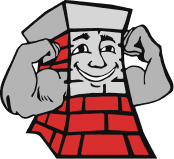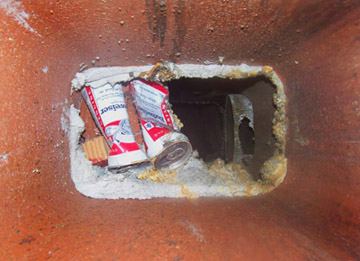Chimney Draft Problems
How Your Chimney Really Works
by Dave Lamb – dave@mychimneys.com
In order to fix a problem, it helps to know a little about how it developed in the first place. There are lots of confusing technical explanations of how chimneys work and how a simple draft problem can result in some very uncomfortable issues. 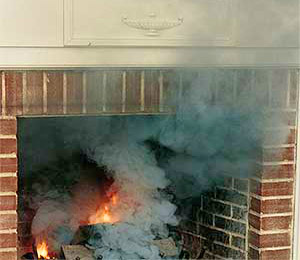 To put it simply, drafting is how well your fireplace displaces the products of a fire into the outside atmosphere. Problems with drafting will result with the smoke and combustion products backing up into your home and polluting the air, and fireplaces that draft correctly will put all of the gases and soot up the chimney and outside where it belongs. There are many factors that can affect the draft and learning about what affects the draft will help you eliminate these problems from occurring.
To put it simply, drafting is how well your fireplace displaces the products of a fire into the outside atmosphere. Problems with drafting will result with the smoke and combustion products backing up into your home and polluting the air, and fireplaces that draft correctly will put all of the gases and soot up the chimney and outside where it belongs. There are many factors that can affect the draft and learning about what affects the draft will help you eliminate these problems from occurring.
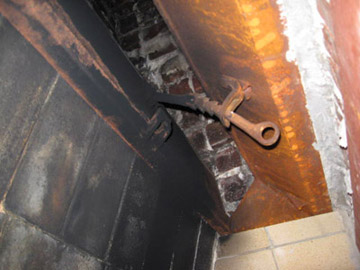
Opening the damper should allow the smoke to enter the chimney. If the damper is not working properly you will have problems with drafting.
A chimney works to dispel the gases and smoke from the fire by following the concept that heat rises. When the hot air and combustion gases rise, they will leave the fireplace and enter into the chimney flue, which is the pipe that carries the smoke and gases to the outside of the home. The concept of heat rising is known as the stack effect. But because the hot air is leaving and thus creating negative air pressure, other cooler air must take the place of this missing air in order for the hot air to leave properly. The problem comes in when cool air is prevented from taking the place of the hot air so the smoke filled air cannot leave as planned and may back up into the room. Thus creating back drafting which is the reversal of the air that is supposed to be leaving through the chimney and that instead comes into the house.
Drafting Factors
A wide range of factors go into whether you will have problems with your fireplace draft. From a blocked off chimney to the incorrect firebox size and design features, there are many components of a chimney that could produce a problem.
Chimneys can get blocked off or clogged as a result of problems or simple mistakes by the homeowner. The problem could be as simple as a plugged or closed damper or someone intentionally blocked off the chimney flue and forgetting about it. Other less obvious causes could be a dirty chimney cap, one that does not fit properly or was installed incorrectly, structural damage, other repairs that were not completed correctly or unwanted animals and insects that have build bothersome nests.
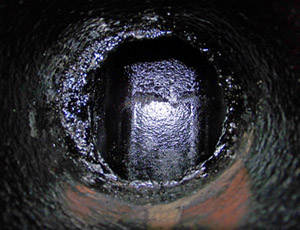 Another common way a chimney passageway can get blocked or partially closed off is by the accumulation of excessive creosote, the soot build-up that can cause chimney fires or blockage. Creosote is dangerous in itself, but it can also cause the combustion gases to back up and add to the existing problems. Creosote buildup on the spark arrester is also another way for the chimney to become blocked. This soot build up on the metal screen can accumulate enough so that it will close off the small openings entirely. A chimney with a clogged passageway or a plugged up chimney cap works like hose with a closed nozzle on it – the harmful gases are not allowed to escape and have no choice but to back up into the home.
Another common way a chimney passageway can get blocked or partially closed off is by the accumulation of excessive creosote, the soot build-up that can cause chimney fires or blockage. Creosote is dangerous in itself, but it can also cause the combustion gases to back up and add to the existing problems. Creosote buildup on the spark arrester is also another way for the chimney to become blocked. This soot build up on the metal screen can accumulate enough so that it will close off the small openings entirely. A chimney with a clogged passageway or a plugged up chimney cap works like hose with a closed nozzle on it – the harmful gases are not allowed to escape and have no choice but to back up into the home.
Another potential reason for a chimney draft to not work effectively could be from the firebox size or location. The firebox must be the correct size to correspond with the chimney flue (the passageway within the chimney walls that the smoke travels through) in order to most effectively pull all of the unwanted gases and smoke into the outside atmosphere. There is a rule that the flue should have at least a 1:10 ration with the firebox so that the system works correctly. Therefore, for every 10 square inches of the firebox there should be at least one square inch opening in the flue. The firebox must also be kept in the correct location for the smoke to exit in the intended manner. The fire should be kept no more than one inch away from the back of the firebox wall. Simply starting the fire more towards the back wall in the fire grate may correct this problem instantly. The fire must also always be made in a grate to provide it enough oxygen, without a fire grate it will smoke and not get hot enough to ventilate properly.
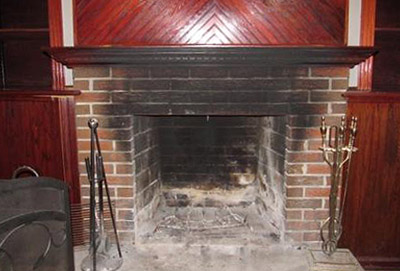 A fireplace with an incorrect design can also affect the draft of your chimney. Fireplace codes are in place to ensure every part of your home is installed correctly. If these codes are not followed correctly, problems may occur. Some of these issues may include, as previously discussed, improper firebox to flue ratio. Along these same lines, the firebox could also be manufactured incorrectly itself. If the firebox is too shallow, typically less than 20 inches, then smoke and combustion gases may enter the room without a chance to leave through the appropriate flue. Flue angles can also cause problems because the heat may not produce enough force to leave through a non-vertical flue.
A fireplace with an incorrect design can also affect the draft of your chimney. Fireplace codes are in place to ensure every part of your home is installed correctly. If these codes are not followed correctly, problems may occur. Some of these issues may include, as previously discussed, improper firebox to flue ratio. Along these same lines, the firebox could also be manufactured incorrectly itself. If the firebox is too shallow, typically less than 20 inches, then smoke and combustion gases may enter the room without a chance to leave through the appropriate flue. Flue angles can also cause problems because the heat may not produce enough force to leave through a non-vertical flue.
The problem may not be with your fireplace at all. In fact, the trouble could be coming from somewhere else in your home. Hot air rises, so the air from your fire leaves through the chimney without a problem usually and the air in the fireplace is then replaced with cooler air from the room, but if there are two appliances pulling air from the room, one may get backed up. For example, another air vent could be the culprit. If an air vent such as a central vacuum, clothes dryer or a forced air furnace is in the same room as the fireplace and they are both working at the same time, this can cause problems as they are both sucking air out of the room. In this case, the fireplace may instead back up and release unwanted smoke into the room instead of dispelling these gases outside. Strong wind may also cause similar problems where the smoke may be pushed back down the chimney and into the room. A new home with tightly sealed walls may also have problems replacing the air that leaves through the top of the chimney. The air that leaves through the top of the chimney along with the gases and smoke must be replaced by something and if the house is too tight and new air cannot be let in, then the air and smoke and gases will pollute the room instead. If this is the only problem, it can usually be resolved by leaving a window open when the fireplace is in use.
If you use green or wet wood, then your fires may not burn hot enough for the hot air to rise and get replaced by cooler air. If this occurs, the smoke and gases will not be able to exit the room. A gas log lighter may help alleviate this problem.
If you have one of these problems and are still not sure what to do about it, follow these simple rules.
1. The first step to take is to hire a certified chimney inspector to take a look at your system and ensure everything is in proper working condition. Draft problems can cause serious health and safety concerns so it is best not to take any chances and get your home inspected to give you and your family peace of mind. Your chimney inspector will recommend any corrective action that may be necessary.
2. Keep your damper open whenever the fireplace is in use.
3. Make sure you use a protective metal screen to shield your hearth from sparks or embers whenever the fire place is in use.
4. If there is a return air vent in the same room as the fireplace check to make sure the unit is not in use before you start a fire.
5. If the home is a new, air tight home, crack open a window to prevent draft problems when the fire is in use.
6. Push the metal fire grate as far back as it will go in the fireplace.
7. To get more draft you can increase the height of the chimney (there is a limit to this as frictional forces may hinder the amount of height you can add)
Now you are all set to enjoy a safe and soothing fire without worrying about filling your home with smoke or harmful gases. The crackling of a fire should be a nice and relaxing time and taking these preventative measures as well as understanding the possibilities of where the problem with the draft is coming from will help to ensure you know what to do if a problem occurs and it will get taken care of without harming your family or home.
If your fireplace is not drafting properly give us a call us at 860-233-5770 and schedule a chimney inspection to determine what the nature of your problem is.


